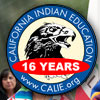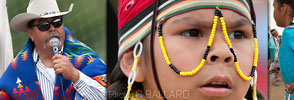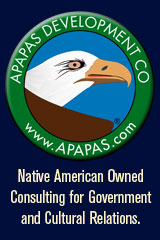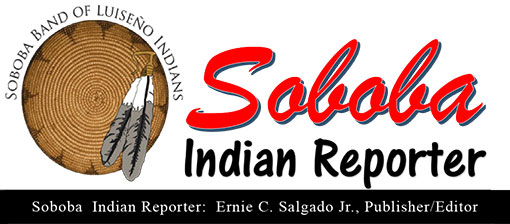 |
 |
 |

Publishing Corner: Indian Community: Science & Wonder Indian Heros: California Indian Art: CALIE Library: Academic Financial Aid: Tribal Governments: Indian Gaming: |
The Birth of the California Indian Education Center Act and the California Indian Health Act, 1973 and 1974By Andy Anderson The Birth of the California Indian Education Center Act and the California Indian Health Act, 1973 and 1974. On New Year’s Eve 2008 my daughter, Culien, went go with Annette and me to see the movie, "Milk." The movie focus is on Harvey Milk the skilled gay rights activist culminating with the assassination of Milk and Mayor George Moscone by Dan White, an ex-San Francisco Supervisor. I never knew or even met Harvey Milk. It was not my cause, Indian rights were. I did know George Moscone as he was the key California Senator to agree to advocate for Indians at a time where finding an Indian legislative champion in California was nearly impossible. The movie "Milk" has prompted me to write up the story on how Joe Carrillo, Dan Bomberry and I were able to get two state Indian laws passed, the first laws in the nation to use state general tax funds for the benefits of American Indians. NATA — Joe Carrillo, Dan Bomberry, Andy AndersonJoe Carrillo, Dan Bomberry and I formed the non-profit NATA Institute in 1972 to advocate for Indian health, education and land rights and to train community organizers towards those goals. NATA stood for Native American Training Associates and NATA quickly became the radical cutting edge Indian organization in California. With success also came enemies including many envious wantabee Indian leaders who mad-mouthed NATA. They derisively called it the Mexican, Canadian Indian and a white guy organization. Joe Carrillo, although having an Hispanic name, was a member of the Tule River Reservation near Porterville, CA. Tule River was one of the poorest reservations in the state with many homes not having running water. If a Tule River Indian wanted a job he had to leave the reservation. Joe was the masterful politician and bar room manipulator since much of the Indian politics in those days took place in smoky and too-much drinking bars. Dan Bomberry, a Canadian Indian, was from the Seven Nations of the Iroquois which does overlap from the northern eastern states into Canada, the white man’s border not the Indian. Dan spent the greater part of his life in California. When I met him he ran the most successful Native American studies program in the California at Long Beach State. Dan was our visionary. Dan had an unique quality that most Indian leaders lacked both on the state and national level. He was able to see beyond the problems of the day, put the issues in historical perspective and carve a vision for seven generations ahead. A mantra, although seldom followed in those days by the Iroquois nation, which was “Make every decision with respect how it might affect the next seven generations.” And me the white guy! Strange as it is with ethnic politics, I took less political heat than either Joe or Dan although I did have my life threatened twice and neither Joe nor Dan ever faced that to my knowledge. I was the NATA administrator, the mop up guy, the soft shoe following the Joe hard shoe. Before I had also enjoyed substantial community organizing success creating the first Indian Education Center in the state on the Bishop Indian Reservation 1968-71. We three had all met through my work with the Indian Education Center work and the post Alcatraz and Wounded Knee occupation that earthquaked the American Indians awake to their oppression by their local communities and by the very federal agencies that were supposed act in their behalf. There are many dramatic, hilarious and unbelievable stories in and around NATA from 1972 to 1978, but this accounting will focus on the passage of the California Indian Education Act and the California Indian Health Care Act. In 1972 when we formed NATA, Indian federal funds did not make it to California which was considered a “non-Indian state.” Indians in other states such as Arizona, New Mexico or South Dakota didn’t think California Indians existed either, or at least, shouldn’t be competing for “their” federal funds. Foundations were not interested in Indians in California. The State had no funding for who-ever these Indians might be. After all Indians were a federal not a state responsibility. The only funding for Indians were some federal/state funds for the Indian studies programs at the university level and small amounts of money that could be carved out of national educational funds via the local county or meager Bureau of Indian Affairs federal funds. The political energy and anger was still churning from Alcatraz, 1969-71, and Wounded Knee in the winter of 1973. We had liberal supportive friends that Joe had made within the State Health Department. Interest in the success of the Bishop Indian Education Center generated a buzz with some state Department of Education employees. Bottom line was that for all our lofty ideas, idealism and anger we had no financial resources to work with. Indians in California were all starving birds fighting over scarce crumbs. Joe, Dan and I decided to take the incredibly bold action of passing state law to use general fund state funds to support the creation of more Indian education centers and to give start-up funding for the new tribal health centers. 1973 was the last year of Ronald Reagan’s administration. We knew our chances were slim to none, but that was before Joe went into action. We had a great ally with the accessible California Health Department, mostly through administrator Irv Rotenberg who Joe had known and worked with. Joe was a part-time consultant with the department. Joe even had the permanent use of a state car which he parked at his house in Davis, again against all rules. Joe had encouraged and detailed how to illegally slide Mother and Child Funding to the nascent Indian clinics. The same office was also our supply for our office supplies. We would enter the Health Department to use their phones, conduct business with our brief cases (large ones) empty. By the time we had finished our organizing phone calls, etc. we would leave the building with our brief cases filled with yellow pads, pens, staplers, toilet paper anything we could get our innocent and sticky hands on. Our goals were an Indian Education Center Act and an Indian Health Act. I went to work drafting the legislative language for the expansion of Indian education centers. Irv Rotenberg went to work drafting legislation for Indian health clinics. But we had no elected Indian champion to carry the legislation. Through Joe’s work, he met Senator George Moscone, a liberal Senator from San Francisco, hardly Indian country. Moscone was one of the state leaders of the Democratic Party. He was enthusiastic, hard working, hard womanizing, but was also hated, really hated by Governor Ronald Reagan. It was known that Ron Reagan said he would veto any legislation that had George Moscone’s name on it, certainly with him as the lead advocate. So we were stuck with Reagan-hated Senator George Moscone as lead for our proposed legislation. Meanwhile Joe’s political brain went into hyper drive. He found a sympatric secretive ear high in Reagan’s administration. I will call him Shallow Throat or ST. ST was not sympatric to the Indian cause but to the pragmatic that Ronald Reagan, desperate to run for President, needed something to soften his anti-minority actions and reputation. After all, as Joe presented, Indians would be cheap to help because we are so few. It would cost a fortune to help Hispanics or Blacks. Even then the insider remained dubious. Meanwhile George Moscone was already busy lining up some supporters, even finding a few Republicans. The language was in final draft. We had none of the tools that lobbyists need: Indians were not numerical, didn’t vote, and had no money and no resources to bargain with. Most tribes had tiny pieces of land, if any, certainly with no natural resources. A letter writing campaign was organized using our State Health Department phones. Ronald Reagan hated the State Health Department which he had accused of being filled with radicals. Early in his term he force-moved the Department from Berkeley to Sacramento. Reagan was right about the radicals, few but visible, but his forced move created a massive pubic employee dislike to his administration among state health workers. Thank the Great Spirit that the Reagan administration had not learned that the legislation had been written in the department and the blatant organizing to pass the legislation had also been done with department resources, we would have been sunk. But no one squealed. We worked the halls of the state legislature, our first effort at lobbying. Perhaps because the legislation was unique and inexpensive the lobbying went surprisingly well. Many legislators owed Moscone favors. This was before George Moscone had decided that he would soon quit the Senate to run for Mayor of San Francisco. We got both bills out of committee and both were passed. But Reagan had not changed his veto threat. Joe went back to ST. Joe had casually implied to his Reagan, ST, that Joe could organize a massive Indian demonstration at the Capital should the Governor not support this legislation. Also that Joe implied that he had many contacts within the newspaper and TV media. This was true, well; maybe not the many part, but certainly some. “Let me get back to you,” said ST. “Here’s the deal,” said ST. “The Governor will sign the less expensive of the two bills, the Indian Education Act.” Summer 1973. We had a minor miracle and our heads swelled. But the job was not finished. We still needed to pass the Indian Health bill. The governorship had changed from conservative Republican to liberal Democrat. We now had Jerry Brown to deal with. Jerry Brown had campaigned heavily that he would not sign any legislation for new funding unless equal funding was cut somewhere else in government. We had access at several high levels with the new Governor, but so did the Black community, the Hispanics, gays and just about every group that had suffered the eight years under Reagan. We had to have an angle to get us to the front of the line and over come Brown’s campaign pledge. Once again we started the Indian Health Act through the legislative process and once again it went well, even better than before since we were now known. Joe had invited Jerry Brown to an Indian ceremony in Susanville an hour north of Reno, complete with press coverage. Jerry agreed to go and went soaking up the earthy energy and the media publicity. At the appropriate time at the ceremony Joe met with Jerry Brown. “It’s going to be hard to satisfy all the minority groups for a while since the state budget is so tight, but you still need to give them something. You should do something to say you still care that you have not forgotten them.” Jerry Brown was all ears. “I can organize a large Indian art show in that huge reception room right outside your office. You could then invite Indian leaders and the press in for the opening. Once that’s done, each month or so you could have an art show for another group.” Jerry Brown loved the idea. “Do it Joe. When can that happen?” asked the Governor. “Let me get back to you on that,” said Joe. We dropped everything to plan the art show and send out invitations to tribal leaders, Indian artists, Indian professors, etc. The opening was a huge hit. The press gobbled it up with Jerry having numerous photos with Indian leaders some in ceremonial dress. We planned the opening to coincide with the day the Indian Health Act would hit Jerry Brown’s desk for his signature. What could the poor man do? He signed it two months after assuming office in 1974. PS: The movie "Milk" was excellent, an example of competent community organizing with all its positive and negative emotions, once instigated, barely in control, reminiscent of our American Indian organizing in California. But it was also a sad reminder that George Moscone was dead only four years after he championed our historical Indian legislation. Thank you George! Submitted by Ernie C. Salgado, Soboba Tribal Member
|
CALIF INDIAN EDU NETWORK: AHMIUM.org | SCAIR.org | SDICENTER.org | APAPAS.com
—
WEB SITE DESIGN
www.calie.org COPYRIGHT 2008-Present • ALL RIGHTS RESERVED

